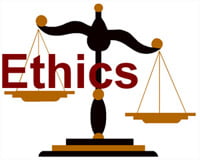Introduction
Ethics is a branch of philosophy that encompasses various dimensions and branches. It is essential to understand these dimensions before delving into the different types of ethics.

Definition of Ethics
“A set of concepts and principles that guide us in determining what behavior helps or harms sentient creatures”
Richard William Paul and Linda Elder
Ethics as a systematic approach to understanding, analyzing, and distinguishing matters of right and wrong, good and bad, and admirable and deplorable as they relate to the well-being of and the relationships among sentient beings.
Karen L. Rich
Ethics is the study of what is good or right in conduct.
Mackenzie
Types of Ethics
The main branches of ethics include meta-ethics, prescriptive ethics, descriptive ethics, and applied ethics. Each branch explores different aspects of ethics and contributes to our understanding of moral principles and values.
Meta-Ethics
Meta-ethics is a branch of ethics that focuses on the nature of ethics itself. It seeks to understand the meaning of ethical terms such as good, bad, right, and wrong.
Meta-ethics delves into the philosophical aspects of ethics, examining the origins of moral and ethical principles and the meaning behind using them. It addresses questions like what is meant by being right or wrong and how we define concepts like “good” or “bad.”
Meta-ethics is concerned with the language we use to discuss morality and aims to analyze and understand the nature of ethics and morality.
For example, when we say, “abortion is good” or “abortion is bad,” meta-ethics explores the meaning and implications of these statements. By studying meta-ethics, we gain a deeper understanding of the foundations and concepts that underpin ethical decision-making.
Prescriptive Ethics
Prescriptive ethics, also known as normative ethics, is the study of ethical action and moral principles. It focuses on determining what is morally right and wrong and provides guidelines for ethical behavior.
Prescriptive ethics encompasses different theories, including deontological ethics, teleological ethics, and virtue ethics.
Deontological ethics emphasizes the duty or obligation behind an action. It focuses on the inherent rightness or wrongness of an action, regardless of its consequences.
Teleological ethics, on the other hand, focuses on the outcomes or consequences of an action. It assesses the morality of an action based on its ability to achieve a desired goal or end.
Virtue ethics emphasizes the development of virtuous character traits and moral virtues in individuals.
Prescriptive ethics involves systematizing, defending, and recommending concepts of right and wrong actions. It helps guide individuals in making ethical decisions and sets moral standards that govern behavior.
For example, prescriptive ethics can help us determine whether it is morally right or wrong to kill one person to save many lives. So by studying prescriptive ethics, we gain insights into moral frameworks and principles that shape our understanding of ethical behavior.
Descriptive Ethics
Descriptive ethics, also known as comparative ethics, focuses on describing and explaining people’s moral attitudes, beliefs, and practices. It aims to understand what people consider to be good, right, virtuous, or morally acceptable. Descriptive ethics is an empirical investigation that explores the moral beliefs of individuals and societies.
This branch of ethics examines how different cultures and societies define and practice morality. It explores questions like how many people think it is wrong to kill a person or what moral rights individuals believe they are entitled to.
Descriptive ethics helps us understand the diversity of moral beliefs and practices across different groups and cultures. It provides valuable insights into how individuals and societies perceive and act upon their moral values.
Applied Ethics
Applied ethics is a branch of ethics that focuses on the application of ethical principles to specific areas or domains. It involves using ethical theories and frameworks to address real-world ethical dilemmas and challenges.
Applied ethics encompasses various fields such as bioethics, cyber ethics, environmental ethics, personal ethics, professional ethics, public ethics, and international ethics.
Bioethics deals with ethical issues related to healthcare, medical research, and the treatment of living beings. Cyber ethics explores the ethical implications of digital technology and online behavior.
Environmental ethics focuses on ethical considerations in relation to the environment and the natural world.
Personal ethics involves individual moral values and principles that guide personal behavior.
Professional ethics sets standards of conduct for professionals in various fields.
Public ethics examines ethical issues in the public sphere, such as governance and public policy. International ethics explores ethical dilemmas and principles in the context of international relations.
Applied ethics provides a practical framework for addressing ethical challenges and making informed decisions in specific domains. It helps individuals and organizations navigate complex ethical issues and promotes ethical behavior and decision-making in various contexts.
Conclusion
Ethics encompasses different dimensions and branches that contribute to our understanding of moral principles and values. Meta-ethics explores the nature and meaning of ethics itself, while prescriptive ethics provides guidelines for ethical action and behavior.
Descriptive ethics focuses on describing and understanding people’s moral beliefs and practices, and applied ethics applies ethical principles to specific domains or areas.
By studying these different types of ethics, we gain insights into the foundations, theories, and applications of ethical decision-making. This understanding helps us navigate moral dilemmas and make informed ethical choices in our personal and professional lives.
Leave a Reply